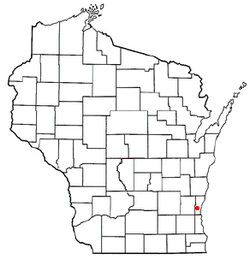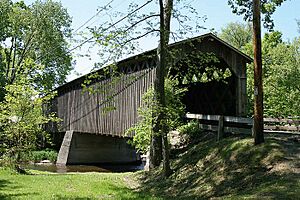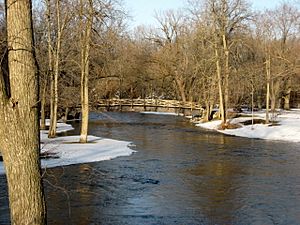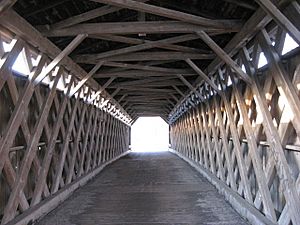Cedarburg (town), Wisconsin facts for kids
Quick facts for kids
Town of Cedarburg, Wisconsin
|
||
|---|---|---|

Town hall
|
||
|
||

Location of Cedarburg (town), Wisconsin
|
||
| Country | ||
| State | ||
| County | Ozaukee | |
| Settled | 1840s | |
| Incorporated | March 2, 1849 | |
| Area | ||
| • Total | 25.8 sq mi (66.9 km2) | |
| • Land | 25.6 sq mi (66.3 km2) | |
| • Water | 0.2 sq mi (0.6 km2) | |
| Elevation | 886 ft (270 m) | |
| Population
(2020)
|
||
| • Total | 6,162 | |
| • Density | 225/sq mi (86.9/km2) | |
| Time zone | UTC-6 (Central (CST)) | |
| • Summer (DST) | UTC-5 (CDT) | |
| Area code(s) | 262 | |
| FIPS code | 55-13400 | |
| GNIS feature ID | 1582937 | |
Cedarburg is a town in Ozaukee County, Wisconsin, USA. It's part of the larger Milwaukee metropolitan area. The town was officially started in 1849. In 2020, about 6,162 people lived there.
German and Irish immigrants first settled in Cedarburg in the 1840s. They created small communities like Decker Corner, Hamilton, and Horns Corners. The City of Cedarburg also grew from this area.
The town has three special places listed on the National Register of Historic Places. These are the Cedarburg covered bridge, the Concordia Mill, and the Hamilton Historic District. The covered bridge is the last old covered bridge in Wisconsin. It's even on the town's logo!
Contents
Exploring Cedarburg's Past
Early Human History in Cedarburg
The oldest signs of people in the Cedarburg area are at the Hilgen Spring Mound Site. This site is near Cedar Creek. It has three mounds built by early people. In 1968, scientists found human burials and old tools there. They found stone altars, arrowheads, and pottery pieces. These mounds were built around 480 BCE, making them very old for Wisconsin.
Native American Tribes and Treaties
In the early 1800s, Native American tribes lived on this land. These included the Potawatomi and Sauk tribes. In 1833, the Potawatomi gave up their land to the United States government. They were asked to leave Wisconsin by 1838. Many moved west, but some stayed. They were called "strolling Potawatomi" because they moved around their old lands. Later, these Potawatomi formed the Forest County Potawatomi Community in northern Wisconsin.
First European Settlements
The first European settlement in the Cedarburg area was called "New Dublin." It later became Hamilton. Joseph Gardenier was the first person to live there. He built a small cabin by Cedar Creek. He was surveying land for the Green Bay Road. By 1848, Hamilton was the first stop for stagecoaches traveling between Milwaukee and Green Bay.
Most early settlers in Cedarburg were German immigrants. Ludwig Wilhelm Groth is often seen as the first settler. He bought land in 1842 and started planning the area along Cedar Creek. The Town of Cedarburg was officially created on March 2, 1849.
Growth and Development with Railways
In 1870, the first train line came through Cedarburg. This line later became part of the Chicago, Milwaukee & St. Paul Railway. Trains helped Cedarburg grow and become successful. Other nearby communities like Hamilton, Decker Corner, and Horns Corners stayed more rural. The City of Cedarburg became its own city in 1885.
The Excelsior Mill was built on Cedar Creek in 1871. It cost $21,000 to build. This mill made both flour and lumber. In 1885, a big fire damaged the mill, and it closed. In 1890, John Weber bought the property. He changed the mill to make wire and nails.
After World War II, Cedarburg grew quickly. More people moved from cities to live in the suburbs. The City of Cedarburg started adding land from the town for new neighborhoods.
Discovering Cedarburg's Geography
The Town of Cedarburg covers about 25.8 square miles (66.9 square kilometers). Most of this area is land, with a small part being water.
The City of Cedarburg is mostly in what used to be the town's southeast part. The town is surrounded by other towns and villages. These include the Town of Saukville and Town of Trenton to the north. To the east are the Village of Grafton and the Town of Grafton. The City of Mequon is to the south, and the Town of Jackson is to the west.
The small communities of Decker Corner, Hamilton, and Horns Corners are also found within the town.
Land and Water Features
Cedarburg is located in an area shaped by glaciers from the last ice age. The soil here is a mix of good draining material, loess, and loam. Underneath this soil is a layer of glacial till. The town also has some Silurian limestone deposits. Early settlers used this limestone to build homes and other structures. Some of these old limestone buildings are still standing today.
Cedar Creek flows through the town. It eventually joins the Milwaukee River in Grafton. The creek's lower parts have some pollution, and people are advised not to eat fish caught there. Mole Creek, another small stream, also flows through the town's Pleasant Valley Nature Park.
Local Wildlife and Plants
Before European settlers arrived, much of Cedarburg was a forest. It had many American beech and sugar maple trees. White cedars grew along Cedar Creek. Much of this forest was cleared for farming. Today, a lot of the town's land is still used for agriculture.
As more land is developed, wild animals sometimes come closer to human areas. You might see white-tailed deer, coyotes, and red foxes in the town. Sometimes, black bears have been seen in Ozaukee County. Many birds, like sandhill cranes and wild turkeys, live in the area. The Cedarburg Bog, just north of the town, is an important bird area. A rare plant called Goldenseal grows in a woodland near the town.
The region also deals with invasive species. These are plants and animals that are not native and can harm the local environment. Examples include the emerald ash borer (an insect), common carp (a fish), and plants like reed canary grass and purple loosestrife.
Who Lives in Cedarburg?
In 2010, there were 5,760 people living in the town. Most residents (98%) were White. There were also smaller numbers of Black, Native American, and Asian residents. About 1.3% of the population was Hispanic or Latino.
Many households (36%) had children under 18 living with them. Most households (78.5%) were married couples. The average household had about 2.8 people. In 2017, the average household income was around $96,771 per year.
Learning in Cedarburg: Schools
Most public school students in the Town of Cedarburg attend schools in the Cedarburg School District. This district has three elementary schools for grades kindergarten through fifth: Parkview, Thorson, and Westlawn. These schools serve both the town and the city.
Webster Middle School teaches students in grades six through eight. Cedarburg High School serves grades nine through twelve. Some students in the northeast part of the town go to the Grafton School District.
A seven-member school board runs the district. They meet once a month at Cedarburg High School. The district also has a superintendent, who is like the head principal for all the schools. The Cedarburg School District is often listed as one of the best schools in Wisconsin.
Getting Around Cedarburg
Roads and Highways
Cedarburg is located west of Interstate 43. This major highway goes through the Town of Grafton. Wisconsin Highway 60 also runs through Cedarburg.
Public Transportation Options
Cedarburg has some public transportation, but not as much as bigger cities. Ozaukee County and the Milwaukee County Transit System offer the Route 143 commuter bus. This bus, also called the "Ozaukee County Express," goes to Milwaukee using Interstate 43. The bus stops at a park-and-ride lot near Cedarburg's highway exits. It runs during busy morning and evening commute times on weekdays.
For places not directly on the bus route, Ozaukee County Transit Services has a Shared Ride Taxi. These taxis operate seven days a week. They can also connect you to transit services in Washington County and Milwaukee County.
Fun and Recreation in Cedarburg

The Town of Cedarburg has seven public parks. It also has three spots where you can launch a canoe on Cedar Creek. Ozaukee County and the Ozaukee Washington Land Trust also maintain parks here. The town's recreation department offers sports like little league baseball, flag football, track and field, and soccer.
Town Parks to Explore
- Cedar Creek Farms Canoe Launch: A small park (0.33 acres) on Cedar Creek. It has a paved parking lot and a wooden platform to launch canoes. It's best for canoeing in spring when the water is high.
- Creekside Park: This 0.56-acre park also has a canoe access point and a gravel parking area. Its wooded areas are great for watching birds.
- Hamilton Park: Located in the Hamilton Historic District, this 1-acre park has picnic tables. It also has a special marker telling about its history.
- Krohn Park: An 11-acre park along Cedar Creek, near Covered Bridge Road. It has walking trails and another canoe access point. There's also a historical marker about the old Kaehlers Mill settlement.
- Orthopaedic Hospital of Wisconsin Fields: A 5.26-acre outdoor sports area with two baseball fields.
- Pleasant Valley Park: This large 88-acre park is owned by both the Town and City of Cedarburg. It used to be a landfill. You can find different natural areas here, like woodlands, prairies, and a bog. It also has landforms called kettles and Mole Creek. The park has a parking lot, a picnic shelter with restrooms, a Boy Scout campground, mountain biking trails, walking trails, and boardwalks.
County and Land Trust Parks
- Covered Bridge Park: This 12-acre park is managed by Ozaukee County. It's home to the last 19th-century covered bridge in Wisconsin. The bridge was built in 1876 and was used for wagons and cars until 1962. Now, only people can walk across it. It was added to the National Register of Historic Places in 1973. The park also has picnic areas, fishing spots, and canoe access.
- Cedarburg Environmental Study Area: This 38-acre nature area is managed by the Ozaukee Washington Land Trust. It has wetlands, ponds, open meadows, and different types of forests. It's a great place to see wildlife and go birdwatching.
Famous People from Cedarburg
- Paul Clement: He was born in the town and later became the United States Solicitor General.
- Humphrey J. Desmond: A Wisconsin lawmaker, lawyer, writer, and newspaper editor.
- William Henry Fitzgerald: Born in the town before Wisconsin became a state, he served as a Wisconsin State Representative.
- George P. Harrington: A Wisconsin lawmaker.
- Eugene J. Poole: Born in the town, he also served as a Wisconsin State Representative.
Images for kids
See also
 In Spanish: Cedarburg (condado de Ozaukee, Wisconsin) para niños
In Spanish: Cedarburg (condado de Ozaukee, Wisconsin) para niños






